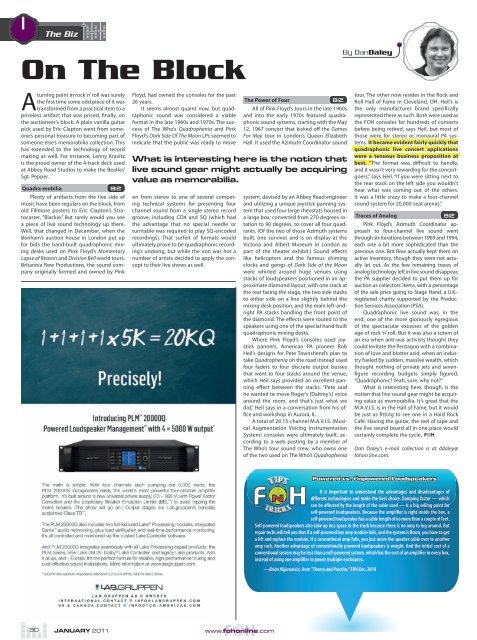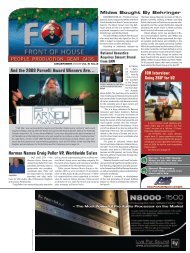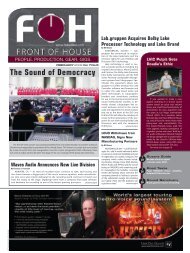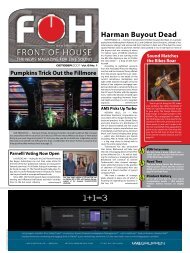Download a pdf - FOH Online
Download a pdf - FOH Online
Download a pdf - FOH Online
Create successful ePaper yourself
Turn your PDF publications into a flip-book with our unique Google optimized e-Paper software.
A<br />
turning point in rock ‘n’ roll was surely<br />
the first time some odd piece of it was<br />
transformed from a practical item to a<br />
priceless artifact that was priced, finally, on<br />
the auctioneer’s block. A plain vanilla guitar<br />
pick used by Eric Clapton went from someone’s<br />
personal treasure to becoming part of<br />
someone else’s memorabilia collection. This<br />
has extended to the technology of record<br />
making as well. For instance, Lenny Kravitz<br />
is the proud owner of the 4-track deck used<br />
at Abbey Road Studios to make the Beatles’<br />
Sgt. Pepper.<br />
Quadra-mobilia biz<br />
Plenty of artifacts from the live side of<br />
music have been regulars on the block, from<br />
old Fillmore posters to Eric Clapton’s Stratocaster,<br />
“Blackie.” But rarely would you see<br />
a piece of live sound technology up there.<br />
Well, that changed in December, when the<br />
Bonham’s auction house in London put up<br />
for bids the hand-built quadraphonic mixing<br />
desks used on Pink Floyd’s Momentary<br />
Lapse of Reason and Division Bell world tours.<br />
Britannia Row Productions, the sound company<br />
originally formed and owned by Pink<br />
30<br />
The Biz<br />
On The Block<br />
Floyd, had owned the consoles for the past<br />
26 years.<br />
It seems almost quaint now, but quadraphonic<br />
sound was considered a viable<br />
format in the late 1960s and 1970s. The success<br />
of The Who’s Quadrophenia and Pink<br />
Floyd’s Dark Side Of The Moon LPs seemed to<br />
indicate that the public was ready to move<br />
on from stereo to one of several competing<br />
technical systems for presenting four<br />
channel sound from a single stereo record<br />
groove, including CD4 and SQ (which had<br />
the advantage that no special needle or<br />
turntable was required to play SQ-encoded<br />
recordings). That surfeit of formats would<br />
ultimately prove to be quadraphonic recording’s<br />
undoing, but while the iron was hot a<br />
number of artists decided to apply the concept<br />
to their live shows as well.<br />
JANUARY 2011 www.fohonline.com<br />
The Power of Four biz<br />
All of Pink Floyd’s tours in the late 1960s<br />
and into the early 1970s featured quadraphonic<br />
sound systems, starting with the May<br />
12, 1967 concert that kicked off the Games<br />
For May tour in London’s Queen Elizabeth<br />
Hall. It used the Azimuth Coordinator sound<br />
What is interesting here is the notion that<br />
live sound gear might actually be acquiring<br />
value as memorabilia.<br />
system, devised by an Abbey Road engineer<br />
and utilizing a unique joystick panning system<br />
that used four large rheostats housed in<br />
a large box, converted from 270 degrees rotation<br />
to 90 degrees, to cover all four quadrants.<br />
(Of the two of those Azimuth systems<br />
built, one survives and is on display at the<br />
Victoria and Albert Museum in London as<br />
part of the theater exhibit.) Sound effects<br />
like helicopters and the famous chiming<br />
clocks and gongs of Dark Side of the Moon<br />
were whirled around huge venues using<br />
stacks of loudspeakers positioned in an approximate<br />
diamond layout, with one stack at<br />
the rear facing the stage, the two side stacks<br />
to either side on a line slightly behind the<br />
mixing desk position, and the main left-andright<br />
PA stacks handling the front point of<br />
the diamond. The effects were routed to the<br />
speakers using one of the special hand-built<br />
quadraphonic mixing desks.<br />
Where Pink Floyd’s consoles used joystick<br />
panners, American PA pioneer Bob<br />
Heil’s designs for Pete Townshend’s plan to<br />
take Quadrophenia on the road instead used<br />
four faders to four discrete output busses<br />
that went to four stacks around the venue,<br />
which Heil says provided an excellent panning<br />
effect between the stacks. “Pete said<br />
he wanted to move Roger’s [Daltrey’s] voice<br />
around the room, and that’s just what we<br />
did,” Heil says in a conversation from his office<br />
and workshop in Aurora, IL.<br />
A total of 28 15-channel M.A.V.I.S. (Musical<br />
Augmentation Voicing Instrumentation<br />
System) consoles were ultimately built, according<br />
to a web posting by a member of<br />
The Who’s tour sound crew, who owns one<br />
of the two used on The Who’s Quadrophenia<br />
By DanDaley<br />
tour. The other now resides in the Rock and<br />
Roll Hall of Fame in Cleveland, OH. Heil’s is<br />
the only manufacturer brand specifically<br />
represented there as such. Both were used as<br />
the <strong>FOH</strong> consoles for hundreds of concerts<br />
before being retired, says Heil, but most of<br />
those were for stereo or monaural PA systems.<br />
It became evident fairly quickly that<br />
quadraphonic live concert applications<br />
were a tenuous business proposition at<br />
best. “The format was difficult to handle,<br />
and it wasn’t very rewarding for the concertgoers,”<br />
says Heil. “If you were sitting next to<br />
the rear stack on the left side you wouldn’t<br />
hear what was coming out of the others.<br />
It was a little crazy to make a four-channel<br />
sound system for 20,000-seat arenas.”<br />
Traces of Analog biz<br />
Pink Floyd’s Azimuth Coordinator approach<br />
to four-channel live sound went<br />
through six iterations between 1969 and 1994,<br />
each one a bit more sophisticated than the<br />
previous one. Brit Row actually kept them on<br />
active inventory, though they were not actually<br />
let out. As the few remaining traces of<br />
analog technology left in live sound disappear,<br />
the PA supplier decided to put them up for<br />
auction as collectors’ items, with a percentage<br />
of the sale price going to Stage Hand, a U.K.registered<br />
charity supported by the Production<br />
Services Association (PSA).<br />
Quadraphonic live sound was, in the<br />
end, one of the more gloriously egregious<br />
of the spectacular excesses of the golden<br />
age of rock ‘n’ roll. But it was also a totem of<br />
an era when anti-war activists thought they<br />
could levitate the Pentagon with a combination<br />
of love and blotter acid, when an industry<br />
fueled by sudden, massive wealth, which<br />
thought nothing of private jets and sevenfigure<br />
recording budgets simply figured,<br />
“Quadraphonic? Yeah, sure, why not?”<br />
What is interesting here, though, is the<br />
notion that live sound gear might be acquiring<br />
value as memorabilia. It’s great that the<br />
M.A.V.I.S. is in the Hall of Fame, but it would<br />
be just as fitting to see one in a Hard Rock<br />
Café. Having the guitar, the reel of tape and<br />
the live sound board all in one place would<br />
certainly complete the cycle.<br />
Dan Daley’s e-mail collection is at ddaley@<br />
fohon line.com.<br />
Powered vs. Unpowered Loudspeakers<br />
It is important to understand the advantages and disadvantages of<br />
N different technologies and make the best choice. Damping factor — which<br />
can be affected by the length of the cable used — is a big selling point for<br />
self-powered loudspeakers. Because the amplifier is right inside the box, a<br />
self-powered loudspeaker has a cable length of no more than a couple of feet.<br />
Self-powered loudspeakers also take up less space in the truck because there is no amp to lug around. But<br />
repair techs will tell you that if a self-powered box amp module fails, and the system is flown, you have to get<br />
a lift and replace the module. If a conventional amp fails, you just move the speaker cable over to another<br />
amp rack. Another advantage of conventionally powered loudspeakers is weight. And the initial cost of a<br />
conventional system may be less than a self-powered system, which has the cost of an amplifier in every box,<br />
instead of using one amplifier to power multiple enclosures.<br />
—Brian Klijanowicz, from “Theory and Practice,” <strong>FOH</strong> Dec. 2010
















